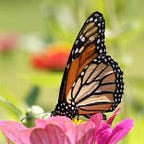FWS Scholar: Tim Whitesel
Tim Whitesel is a Conservation Scientist from the Columbia River Fish and Wildlife Conservation Office in Vancouver, Washington. He was born and raised in the hidden gem of Western New York and now has lived in the majestic Pacific Northwest for over half of his life.
He holds a Bachelor’s of Science in Biology and a Bachelor’s of Art in Philosophy from SUNY at Fredonia, a Master’s of Science in Zoology and a Ph.D. in Biological Sciences from the University of Rhode Island. Tim completed Post Doctoral work at the University of Rhode Island’s School of Oceanography and Rutgers University’s Marine Field Station.
At work, Tim’s duties vary from day to day but include writing, analysis, conducting studies, both lab and field work on various species including Bull Trout, Coastal Cutthroat Trout, Pacific Lamprey, Western Brook Lamprey, Western Pearlshell Mussels. An important part of Tim’s job is supervising a couple of groups of folks, collectively, their activities revolve around conducting scientific investigations to support the conservation of aquatic species and their habitats.
Tim’s position with the Fisheries & Aquatic Conservation program of the USFWS has given him the opportunity to be involved in a great deal of very interesting research, which has been done with a whole lot of people who really deserve most of the credit. Check out Whitesel’s most recent work titled, Evaluation of Larval Pacific Lamprey Occupancy of Habitat Restoration Sites in the Portland Harbor Superfund Area and Assessment of Bull Trout Passage during Operation of the Imnaha River Weir, 2020 Annual Progress Report.
As recently as 2007, managers of large rivers such as the Columbia and Willamette generally viewed mainstem areas as migratory habitat occupied by juvenile Pacific Lamprey for short periods throughout a year. They were able to combine sampling technology from Sea Lamprey investigations in the Great Lakes and quantitative approaches to occupancy sampling and explore the use of deep-water, mainstem areas of these rivers as potential rearing habitat for larvae. By 2012, they were able to demonstrate that larvae of multiple size classes occupy these areas, likely in very large numbers. This helped to change the thinking about habitat that is important for the conservation of Pacific Lamprey and, in 2021, it is now second nature for most managers to think of larvae as rearing in deep-water, mainstem habitats throughout the year.
The world is becoming more and more urbanized and habitats associated with urbanization are becoming critically important to numerous species. It is often unclear whether these habitats can support healthy populations of native species. Multiple scientists across the Fish & Aquatic Conservation Program as well as the City of Portland evaluated the Coastal Cutthroat Trout in Tryon Creek, one of the largest urban watersheds in Portland, Oregon. Tim and others found the characteristics of Coastal Cutthroat Trout in Tryon Creek to be similar to those from populations not influenced by urbanization. This suggests that urban streams can support a healthy population of Coastal Cutthroat Trout, and possibly other salmonids, and demonstrates the potential value of urban streams to the conservation of native fish.
Another area of Tim’s research has been on Bull Trout, which are listed as threatened under the Endangered Species Act. Bull trout can express both migratory and resident life history forms but little is known about the relationship between these forms and how that might factor into recovery. They were able to partner with Utah State University and begin to explore this relationship. Through their studies, they found that different life history forms of Bull Trout that co-occur in the same stream were genetically indistinguishable and did not appear to mate assortatively, where individuals with similar phenotypes mate with one another more frequently than would be expected under a random mating pattern. This work highlighted that, while Bull Trout populations may be managed as single reproductive units, specific phenotypes within a population may be important considerations for long-term conservation.
One of Tim’s major hobbies is coaching. He’s passionate about family, science, the wonderful world of nature and basketball. “It really isn’t possible to nail down one, single, favorite part of what I do but, doing science with extremely curious students is very high on the list,” Tim explains. He loves helping people that are relatively new to the field, appreciate and develop their ability in the scientific process, with an aim toward knowledge for conservation, so that humans may live responsibly as part of the planet. To him it is important and certainly rewarding!
The Science Of The Service event is an annual event featuring presentations by numerous FWS employees, their partners and students throughout the region on the science they are conducting. It’s held in legacy Region 1 and is one of Tim’s favorite parts of his job. This annual event has been happening for over five years now and Tim has been fortunate enough to be part of the organizing team since the inception of the event. Science Of The Service is important because it allows those doing science in the region to showcase their science, communicate the implications of their science, especially to policy and decision makers, and receive feedback on their science, which is critical to the continual improvement and progress.
To learn more about Tim Whitesel’s research and conservation of aquatic species like cutthroat trout, lamprey, check out his paper published in the Journal of Fish and Wildlife Management, “A stepwise approach to assess the occupancy state of larval lampreys in streams,” discoverable via USFWS Conservation Library. #FWSscholar is brought to you by the USFWS Conservation Library, #WeAreUSFWS.
